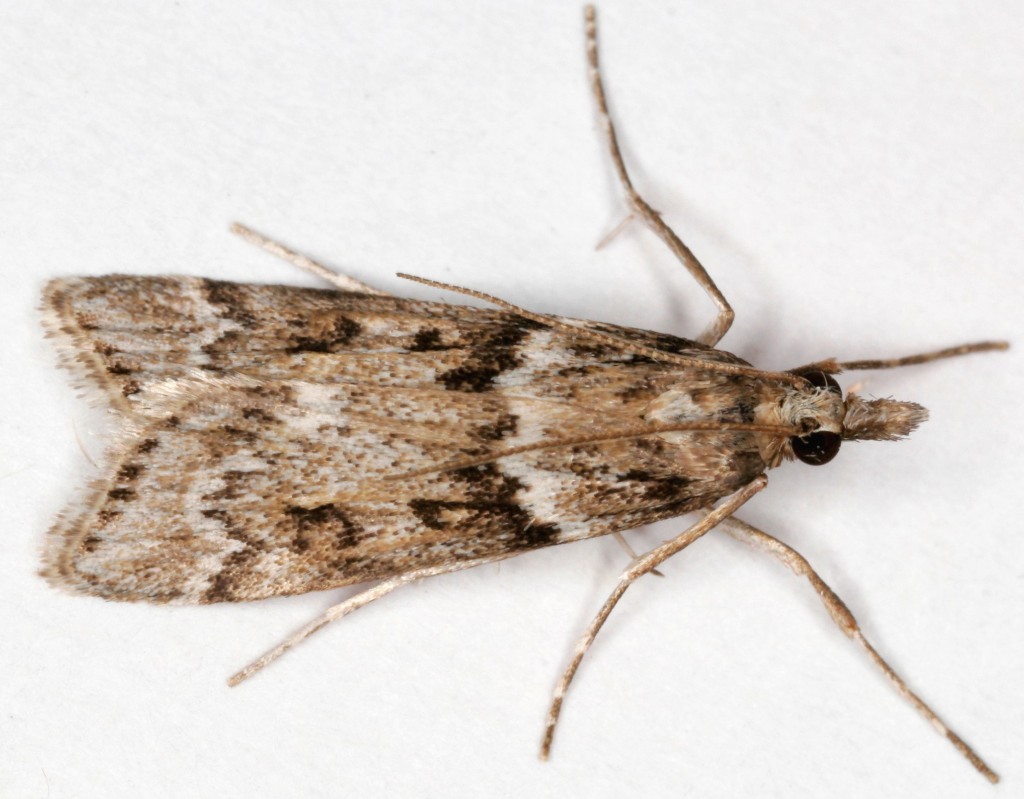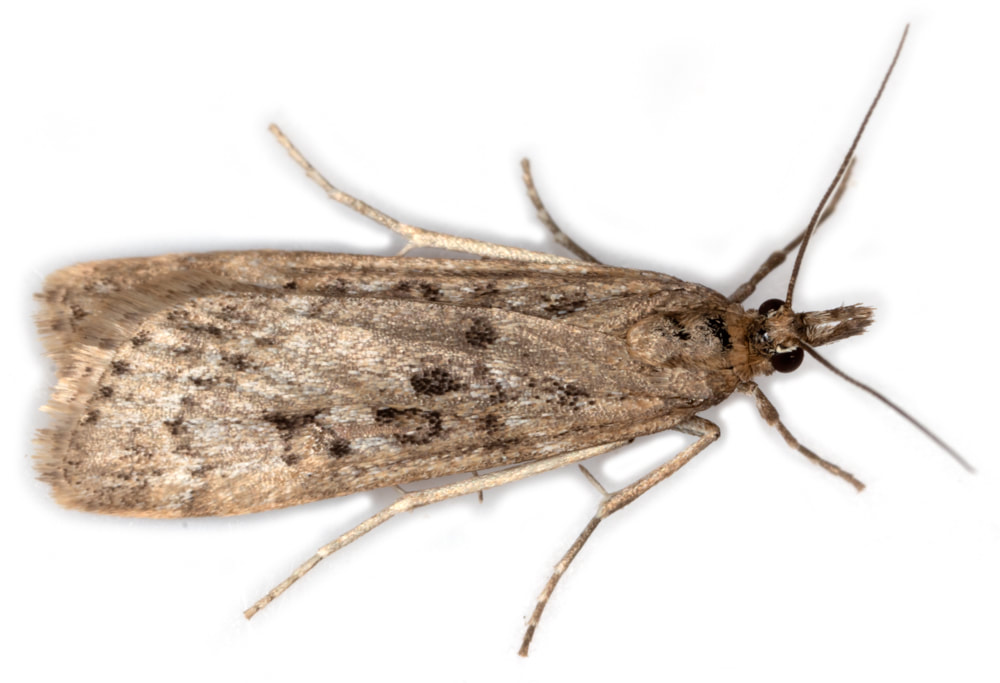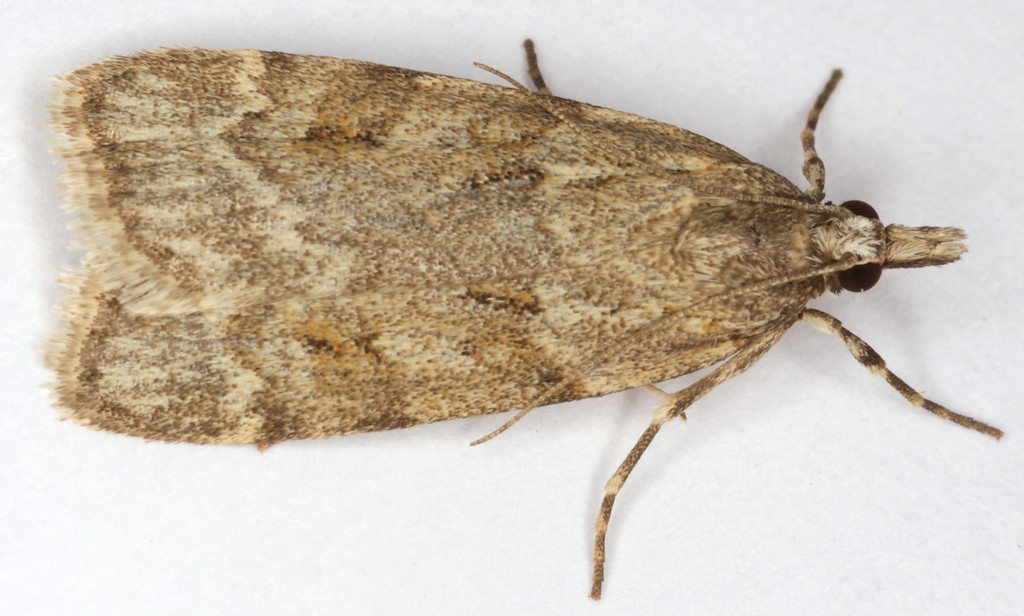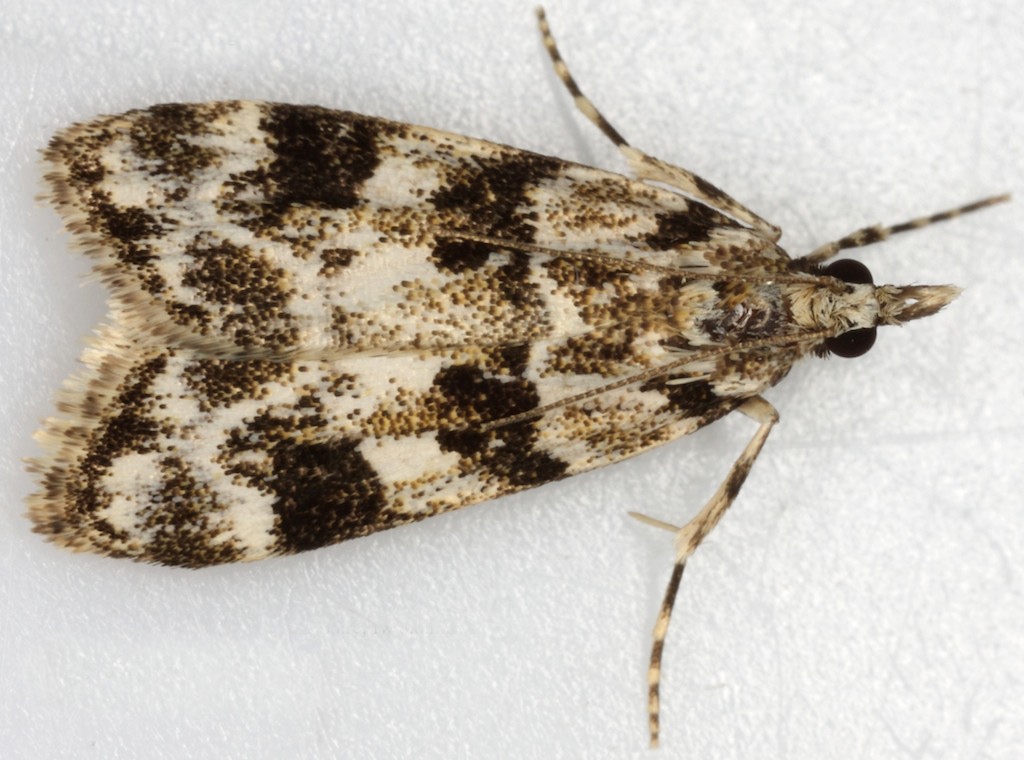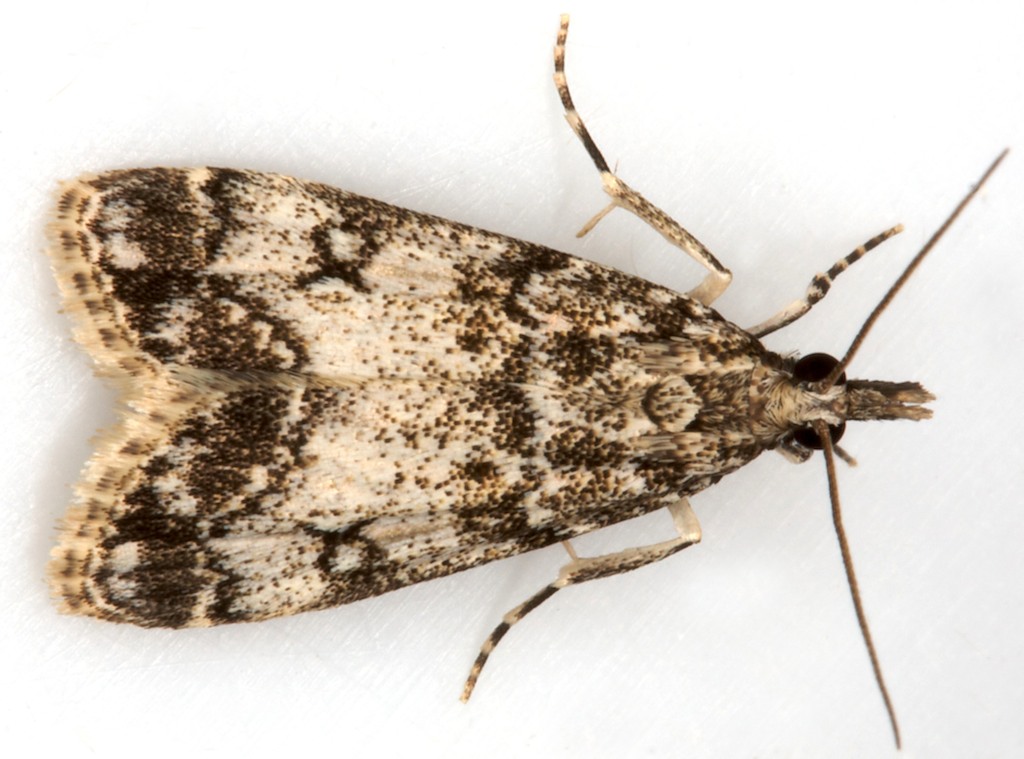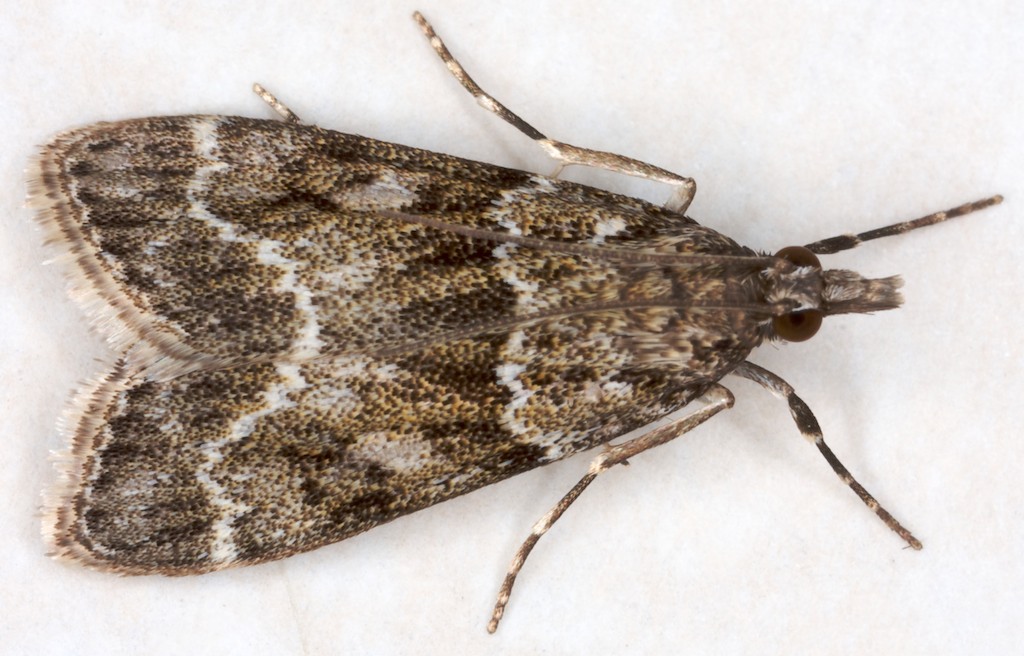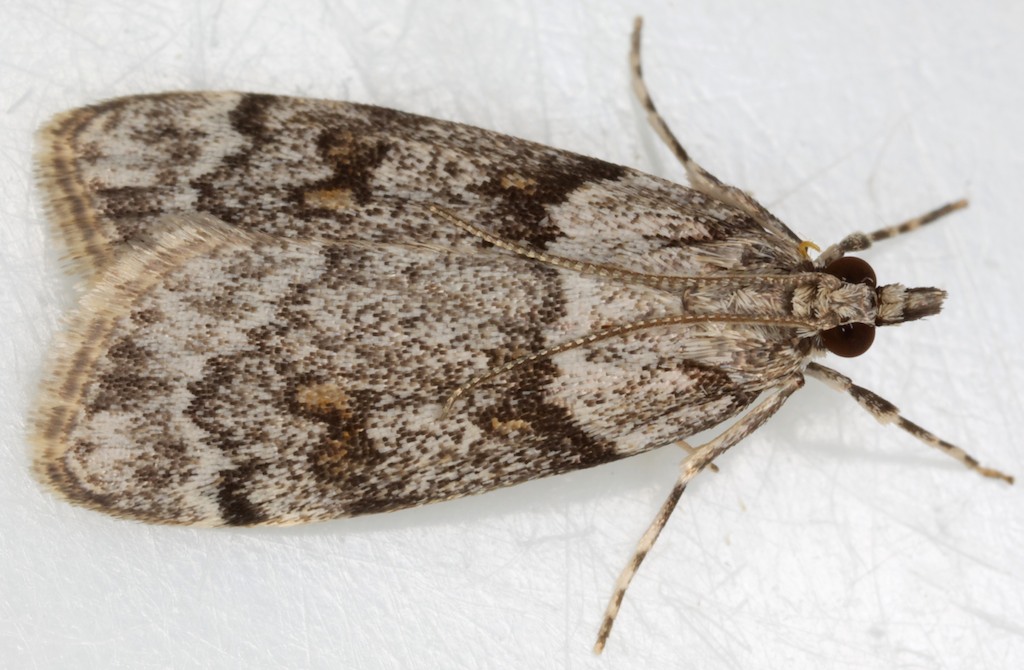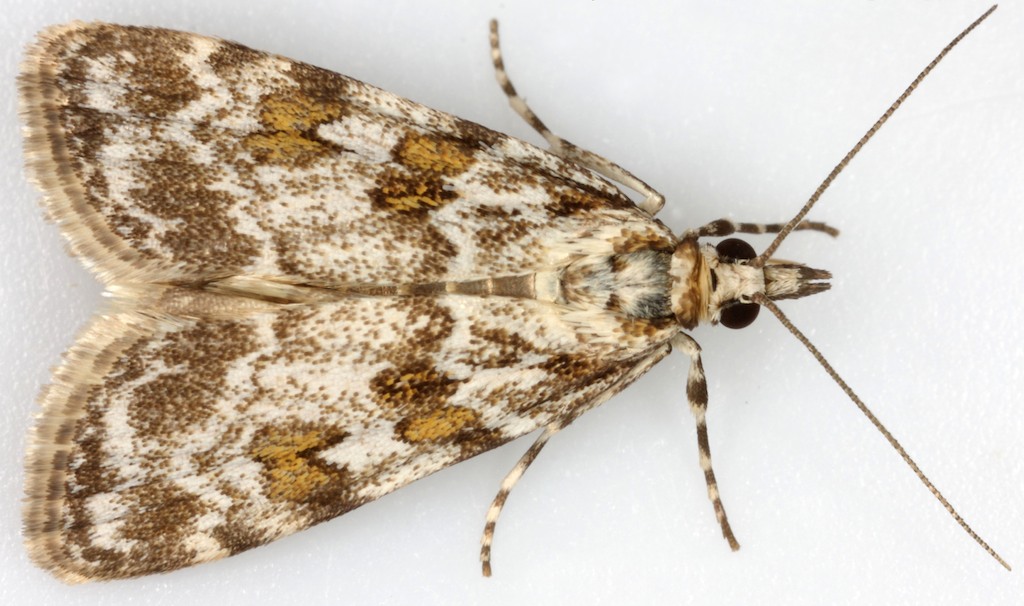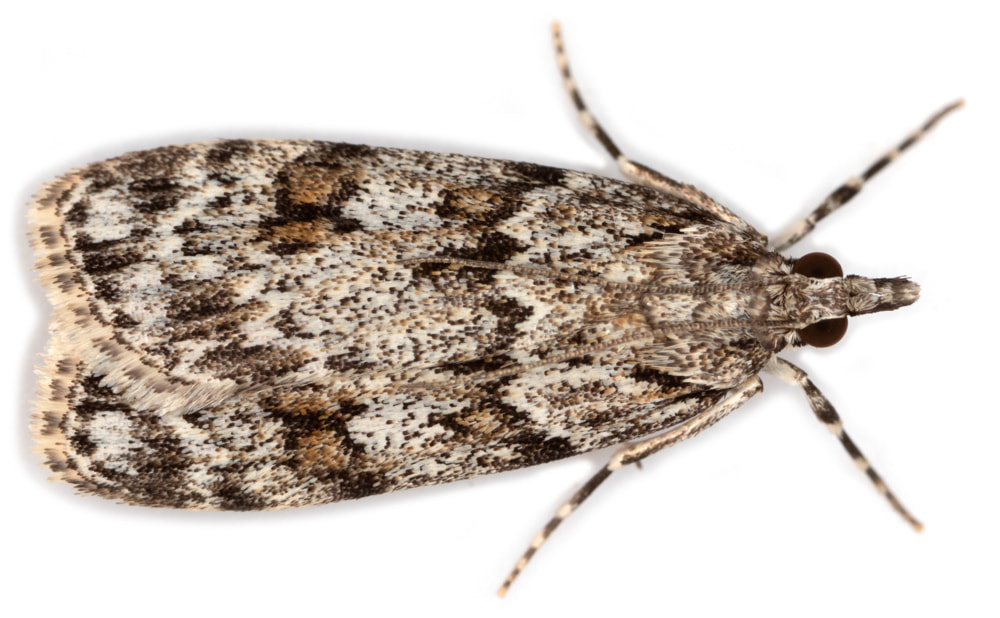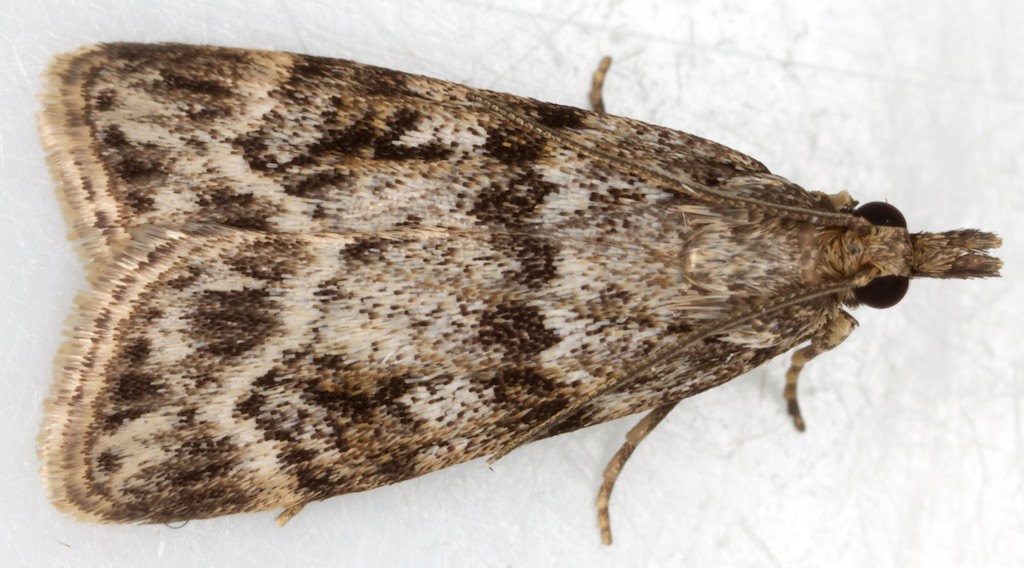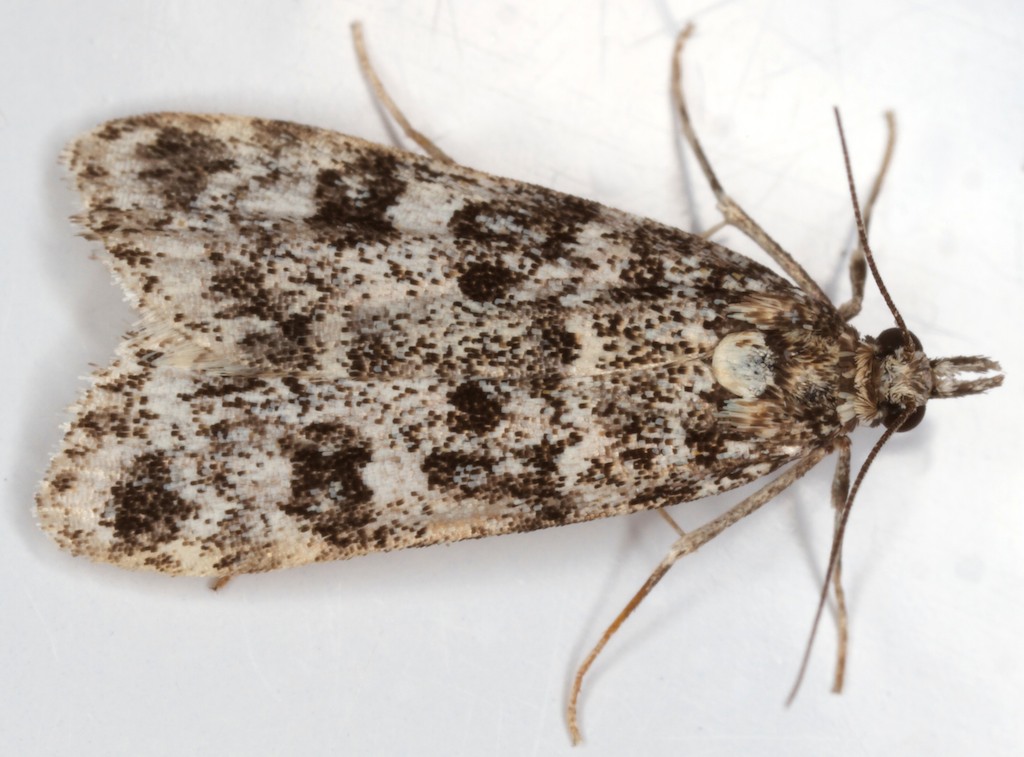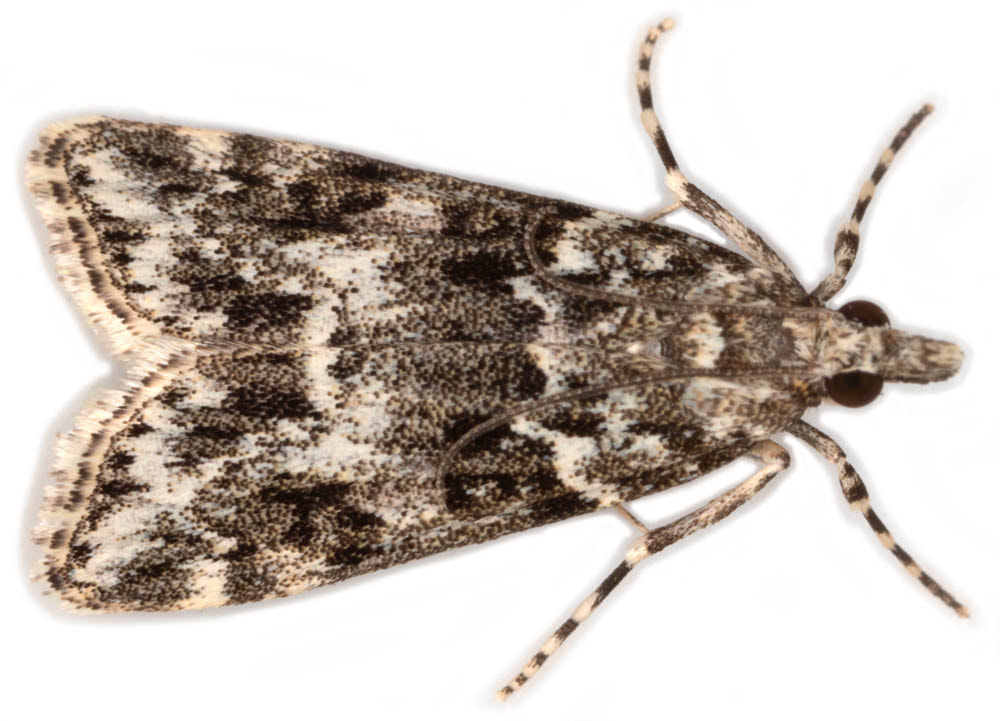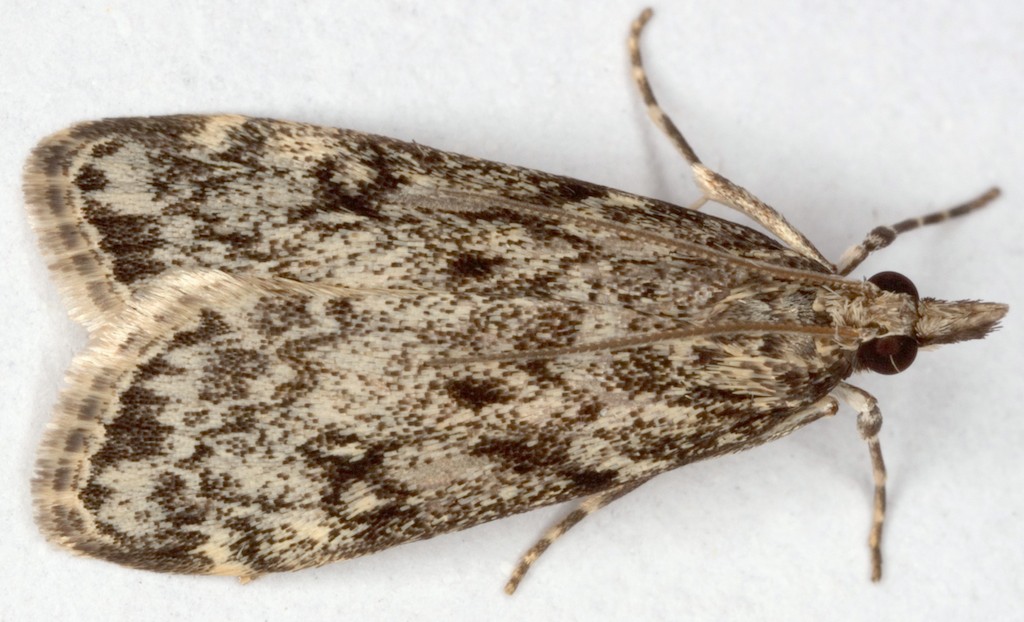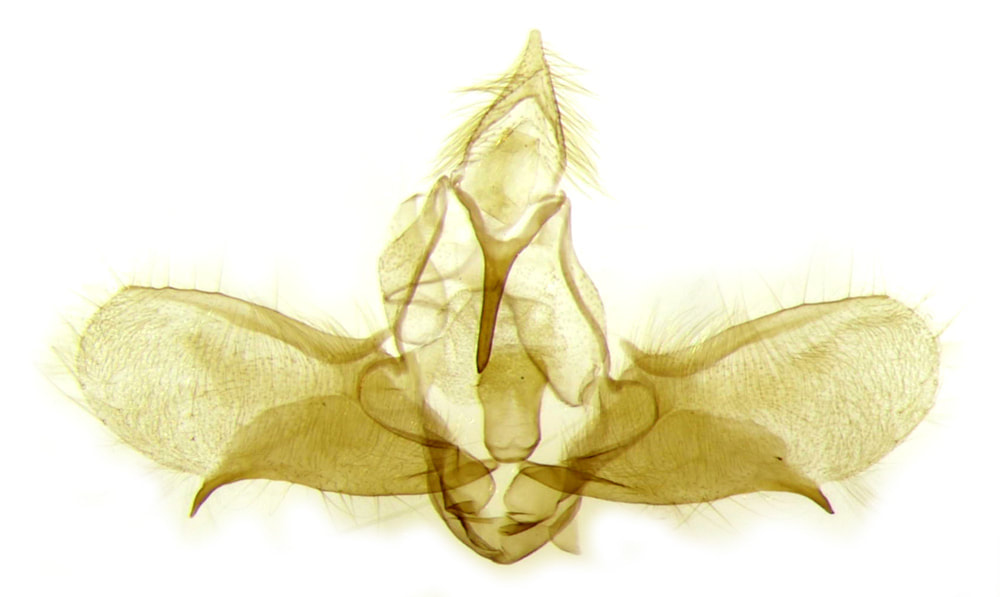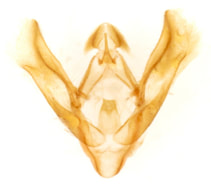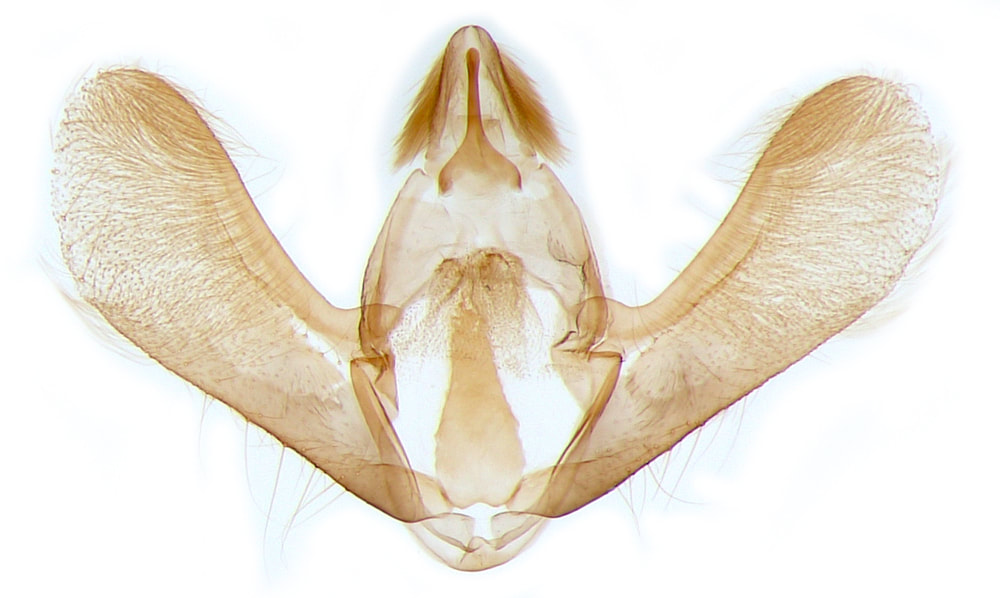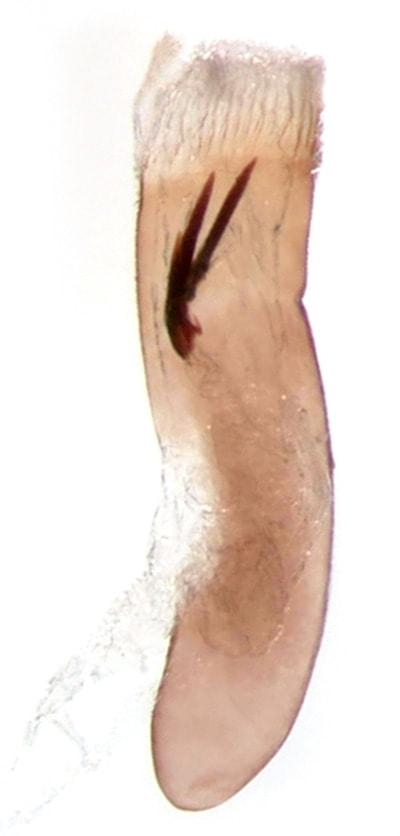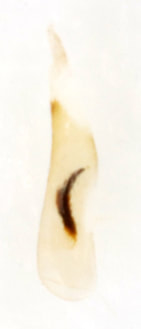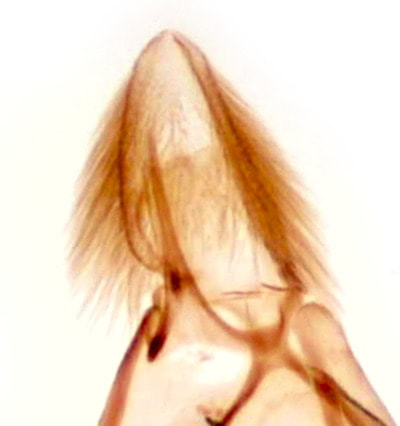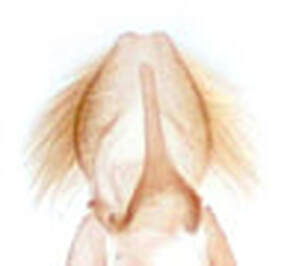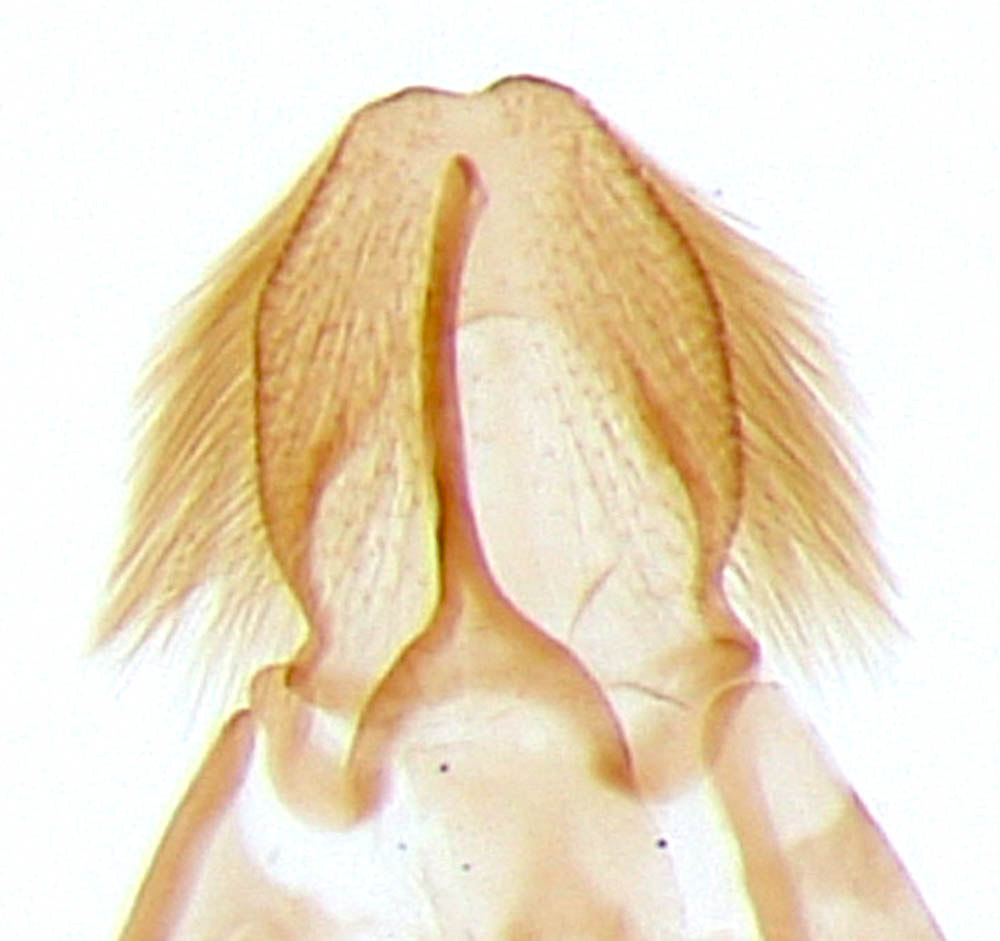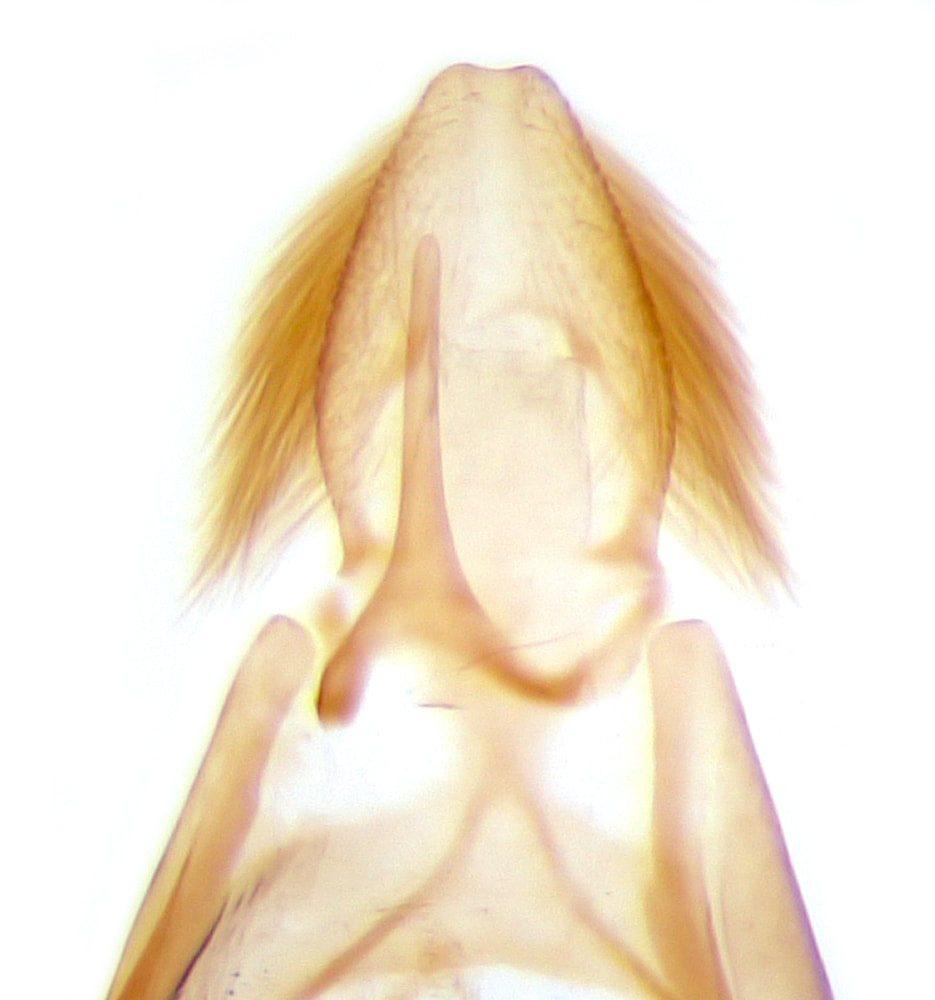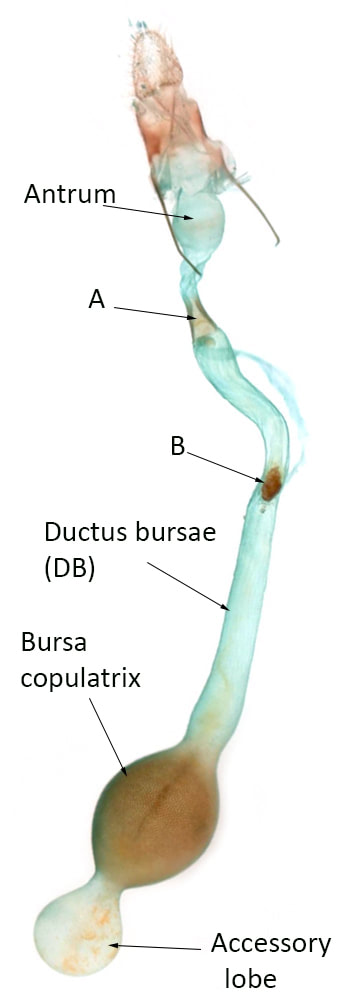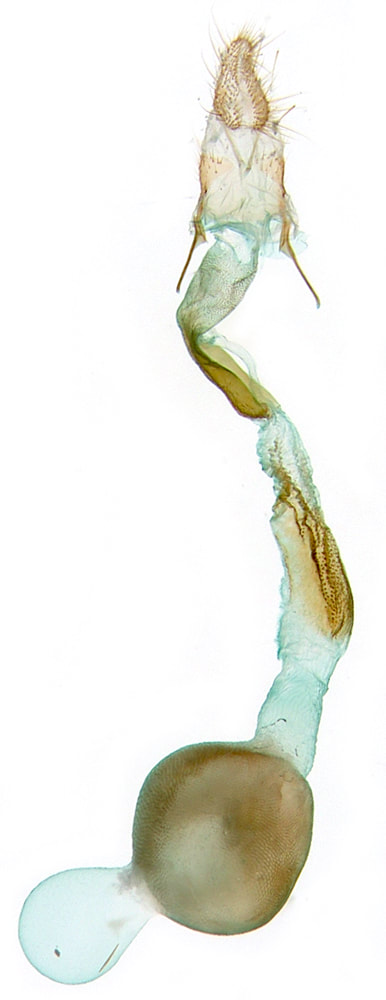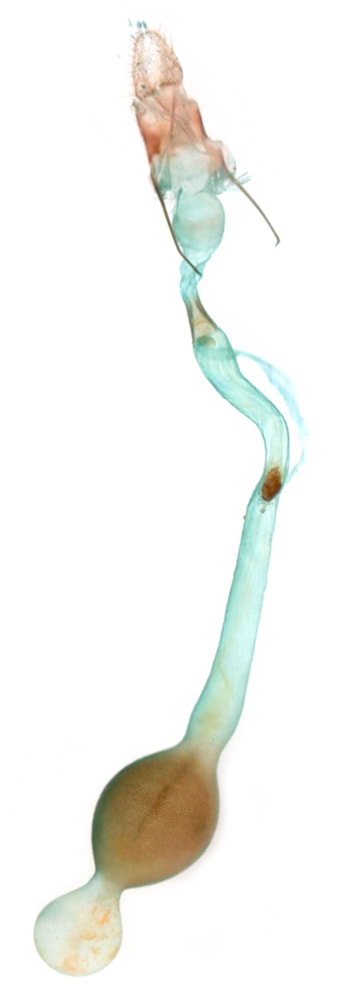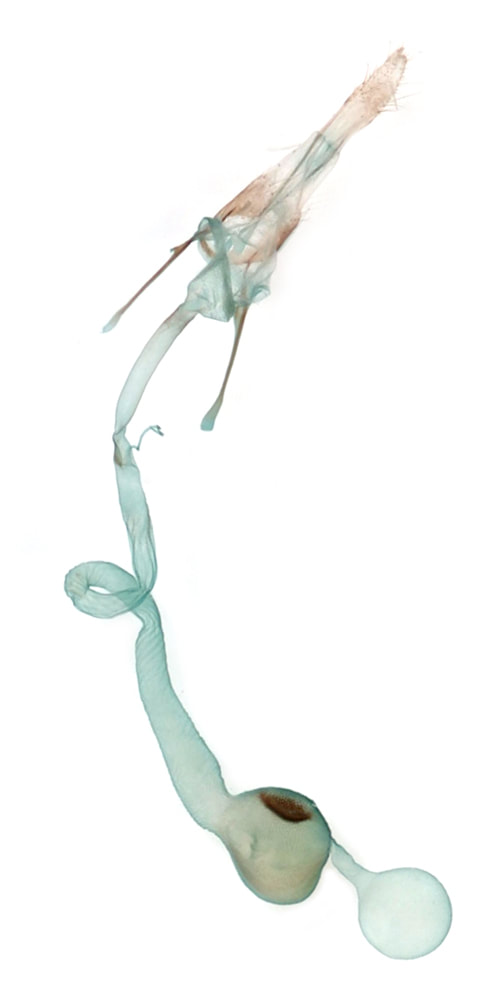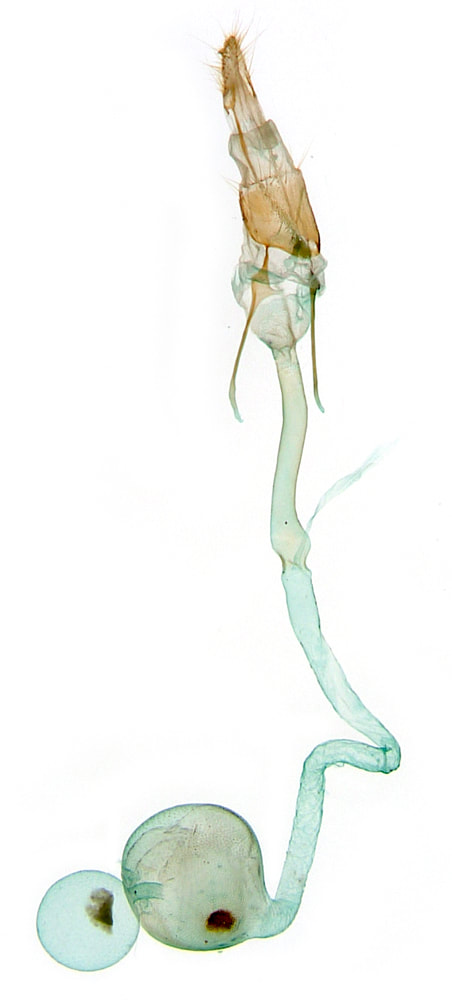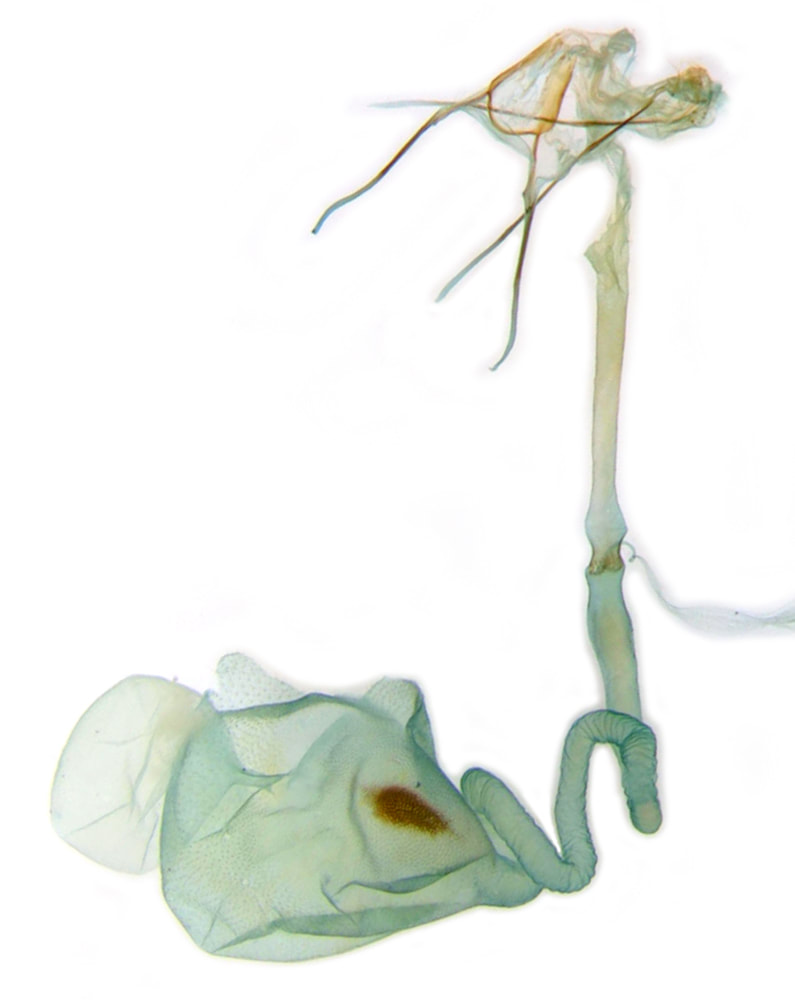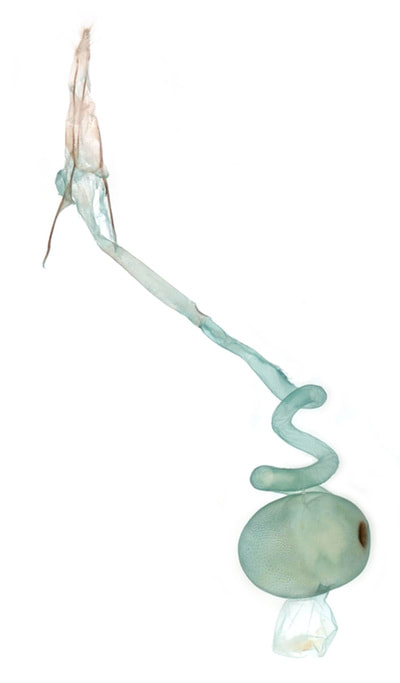Identification of Scopariinae
External features:
Typically Scoparines are black and/or brown and white, with white antemedian and postmedian lines and more or less discrete stigmata, the more proximal of which is round or oval and the more distal of which is usually x or ∞ - shaped. Most are confusingly similar, and each species shows a degree of variability, making confident specific identification on external features highly problematic for many specimens. With practice most specimens of some species are distinctive enough to be identified on external features, but some specimens of most species will need dissection for confident identification.
1. Narrow wing shape
Two Scoparines have distinctly narrow forewings; E.angustea is small (fw: 8-10mm) and widespread; E.alpina is large (fw: 10-12mm) and occurs only above 700m in the Scottish Highlands
2. Antemedian line obsolete
In E.pallida (fw: 8-9mm) the antemedian line is obsolete or obsolescent while the postmedian line is well-defined; the forewing is generally pale with a darker subterminal fascia and weakly marked stigmata. S.subfusca is similarly pale and weakly-marked but is larger (fw: 10-13mm) and the two crosslines are equally weakly marked.
3. Large size (fw 11mm+)
S.subfusca can usually be recognised by a combination of size and weak markings. Smaller specimens (with forewing 10-11mm overlap in size with several other species, but these other species are usually more distinctly marked. The largest E.murana can have fw 12mm.
Typically Scoparines are black and/or brown and white, with white antemedian and postmedian lines and more or less discrete stigmata, the more proximal of which is round or oval and the more distal of which is usually x or ∞ - shaped. Most are confusingly similar, and each species shows a degree of variability, making confident specific identification on external features highly problematic for many specimens. With practice most specimens of some species are distinctive enough to be identified on external features, but some specimens of most species will need dissection for confident identification.
1. Narrow wing shape
Two Scoparines have distinctly narrow forewings; E.angustea is small (fw: 8-10mm) and widespread; E.alpina is large (fw: 10-12mm) and occurs only above 700m in the Scottish Highlands
2. Antemedian line obsolete
In E.pallida (fw: 8-9mm) the antemedian line is obsolete or obsolescent while the postmedian line is well-defined; the forewing is generally pale with a darker subterminal fascia and weakly marked stigmata. S.subfusca is similarly pale and weakly-marked but is larger (fw: 10-13mm) and the two crosslines are equally weakly marked.
3. Large size (fw 11mm+)
S.subfusca can usually be recognised by a combination of size and weak markings. Smaller specimens (with forewing 10-11mm overlap in size with several other species, but these other species are usually more distinctly marked. The largest E.murana can have fw 12mm.
4. Prominent black blotches, on or near the forewing costa
E.delunella (fw: 8-9mm) has prominent more-or-less discrete black blotches proximal to the white postmedian line, distal to the white antemedian line, and at the wing base.
5. Clear whitish central part of the wing between the antemedian and postmedian lines
Most species show a large amount of black irroration of the central part of the wing, but in E.lacustrata this irroration is often sparse, so that this part of the forewing appears relatively clear white, with a prominent X-shaped distal stigma; and the subterminal fascia is contrastingly black. Where E.lacustrata does show dark suffusion of this area there always(?) a clear white patch between the dorsal arms of the X. The subterminal line of E.lacustrata is never(?) complete, always showing a dark gap ~level with the convexity of the postmedian line. These last two features can be used to exclude E.lacustrata rather than to confirm it however, as both may be seen in other species.
6. Overall dark appearance
E.mercurella (fw: 7-9mm) is usually recognisable by its generally dark appearance with a broad darker band along the distal edge of the pale antemedian line. The pale postmedian line is usually distinct against the dark ground colour. S.basistrigalis can be dark enough to be confused with E.mercurella but it is larger (fw:10-11mm). The hindwing of E.mercurella is grey and is darker than in all other Scoparine species except E.alpina.
7. Basal and subterminal fasciae pale, median fascia contrastingly darker
S.ancipitella has this pattern, and the stigmata may also be brownish
8. Stigmata brown and ground colour brownish (rather than grey or blackish)
Specimens with this description are usually S.pyralella
E.delunella (fw: 8-9mm) has prominent more-or-less discrete black blotches proximal to the white postmedian line, distal to the white antemedian line, and at the wing base.
5. Clear whitish central part of the wing between the antemedian and postmedian lines
Most species show a large amount of black irroration of the central part of the wing, but in E.lacustrata this irroration is often sparse, so that this part of the forewing appears relatively clear white, with a prominent X-shaped distal stigma; and the subterminal fascia is contrastingly black. Where E.lacustrata does show dark suffusion of this area there always(?) a clear white patch between the dorsal arms of the X. The subterminal line of E.lacustrata is never(?) complete, always showing a dark gap ~level with the convexity of the postmedian line. These last two features can be used to exclude E.lacustrata rather than to confirm it however, as both may be seen in other species.
6. Overall dark appearance
E.mercurella (fw: 7-9mm) is usually recognisable by its generally dark appearance with a broad darker band along the distal edge of the pale antemedian line. The pale postmedian line is usually distinct against the dark ground colour. S.basistrigalis can be dark enough to be confused with E.mercurella but it is larger (fw:10-11mm). The hindwing of E.mercurella is grey and is darker than in all other Scoparine species except E.alpina.
7. Basal and subterminal fasciae pale, median fascia contrastingly darker
S.ancipitella has this pattern, and the stigmata may also be brownish
8. Stigmata brown and ground colour brownish (rather than grey or blackish)
Specimens with this description are usually S.pyralella
I have not been convinced of any external features which will reliably identify: S.basistrigalis, S.ambigualis, E.murana, E.lineola, E.truncicolella, or E.pyralella when the stigmata are not noticeably brown (most of them), E.lacustrata when the dark irroration is more marked than usual and some atypical specimens of E.mercurella.
Amongst these 5 species males of the two genera are readily separated on genital examination and the 2 Scoparia species can then be distinguished from each other on differences in the cornuti (see below). There are no absolutely reliable differences in the male genitalia of the 3 Eudonia species (but see below).
E.murana is largely confined to moorland in N.England, Wales and Scotland and can probably be excluded away from this habitat - but E.truncicolella is also common in moorland. The only absolute difference in the male appears to be the presence of a hamus found in association with the wing coupling mechanism on the underside of the forewing in E.murana and its absence in E.truncicolella - an image of this structure can be found at Moth Dissection - but I have never been able to identify it. There is a potential difference in the shape of the postmedian line (quoted in "The Dreadful Scopariinae" - Tony Davis, 2003) - in E.truncicolella the costal end of the postmedian line is angled towards the wing base, while in E.murana it is angled towards the apex (this difference is illustrated in Goater but you need a magnifying glass to see it, but not in Sterling and Parsons). (Davis also notes that the pattern of the forewing fringe is such that in E.murana the black and white blocks are equal in size while in E.truncicolella the black marks are broader than the white intervals - but I have not yet been convinced of any consistency between postmedian line pattern and fringe pattern). Sterling Parsons state that the forewing of E.murana is less elongate than that of E.truncicolella and that the distance between the antemedian and postmedian lines at the dorsum is closer in E.murana.
E.lineola is said by Sterling & Parsons to feed on the lichen Xanthoria parietina (Maritime Sunburst Lichen) and by UKMoths to feed especially on Parmelia species (which grows on trees). Both agree that it has a generally coastal distribution and that it flies mainly in July & August. It may be that habitat will separate E.lineola from E.murana. In distinguishing E.lineola from E.truncicolella – Goater states that E.lineola is "irregularly sprinkled with black and olive fuscous scales, the latter imparting a characteristic tint found in no other species in the subfamily". Dave Grundy (personal communication) uses a 90° change in the direction of the postmedian line as diagnostic - this line starts perpendicular to the dorsum then turns ~90° towards the termen, then recurves towards the costa and then a little towards the base before turning sharply, again through ~90° towards the costa; it is the first of these two 90° turns that is relevant as the 2nd is shown by other species - and has proved a distinctive marking in my very limited experience of this species.
E.murana is largely confined to moorland in N.England, Wales and Scotland and can probably be excluded away from this habitat - but E.truncicolella is also common in moorland. The only absolute difference in the male appears to be the presence of a hamus found in association with the wing coupling mechanism on the underside of the forewing in E.murana and its absence in E.truncicolella - an image of this structure can be found at Moth Dissection - but I have never been able to identify it. There is a potential difference in the shape of the postmedian line (quoted in "The Dreadful Scopariinae" - Tony Davis, 2003) - in E.truncicolella the costal end of the postmedian line is angled towards the wing base, while in E.murana it is angled towards the apex (this difference is illustrated in Goater but you need a magnifying glass to see it, but not in Sterling and Parsons). (Davis also notes that the pattern of the forewing fringe is such that in E.murana the black and white blocks are equal in size while in E.truncicolella the black marks are broader than the white intervals - but I have not yet been convinced of any consistency between postmedian line pattern and fringe pattern). Sterling Parsons state that the forewing of E.murana is less elongate than that of E.truncicolella and that the distance between the antemedian and postmedian lines at the dorsum is closer in E.murana.
E.lineola is said by Sterling & Parsons to feed on the lichen Xanthoria parietina (Maritime Sunburst Lichen) and by UKMoths to feed especially on Parmelia species (which grows on trees). Both agree that it has a generally coastal distribution and that it flies mainly in July & August. It may be that habitat will separate E.lineola from E.murana. In distinguishing E.lineola from E.truncicolella – Goater states that E.lineola is "irregularly sprinkled with black and olive fuscous scales, the latter imparting a characteristic tint found in no other species in the subfamily". Dave Grundy (personal communication) uses a 90° change in the direction of the postmedian line as diagnostic - this line starts perpendicular to the dorsum then turns ~90° towards the termen, then recurves towards the costa and then a little towards the base before turning sharply, again through ~90° towards the costa; it is the first of these two 90° turns that is relevant as the 2nd is shown by other species - and has proved a distinctive marking in my very limited experience of this species.
Male genitalia
The two genera are distinguished by features of the male genitalia. In Scoparia the valvae have a process projecting from the ventral edge at approximately halfway, the uncus is pointed and there are cornuti in the aedeagus, which show a unique arrangement in each species. In Eudonia the ventral edge of the valvae is smooth (although there is a hint of a process in E.lacustrata which has previously been sufficient to place it in a separate genus: Dipleurina), the uncus is blunt or notched and the aedeagus lacks cornuti.
The two genera are distinguished by features of the male genitalia. In Scoparia the valvae have a process projecting from the ventral edge at approximately halfway, the uncus is pointed and there are cornuti in the aedeagus, which show a unique arrangement in each species. In Eudonia the ventral edge of the valvae is smooth (although there is a hint of a process in E.lacustrata which has previously been sufficient to place it in a separate genus: Dipleurina), the uncus is blunt or notched and the aedeagus lacks cornuti.
Scoparia
S.subfusca and S.basistrigalis have two discrete cornutal bundles. In S.subfusca each bundle consists of 1 or 2 (or 3?) strong cornuti arising from a relatively small plate at their base, which is much shorter than any of the cornuti; In S.basistrigalis each bundle consists of ~5 medium to strong cornuti arising from a linear plate at least as long as some medium cornuti.
S.ambigualis has 2 strong (and another variable) cornuti, attached at their base.
S.ancipitella has a single strong curved/sickle-shaped cornutus.
S.pyralella has a single bundle of ~5 relatively fine cornuti, progressively longer from base to apex, arising from a linear base plate.
S.subfusca and S.basistrigalis have two discrete cornutal bundles. In S.subfusca each bundle consists of 1 or 2 (or 3?) strong cornuti arising from a relatively small plate at their base, which is much shorter than any of the cornuti; In S.basistrigalis each bundle consists of ~5 medium to strong cornuti arising from a linear plate at least as long as some medium cornuti.
S.ambigualis has 2 strong (and another variable) cornuti, attached at their base.
S.ancipitella has a single strong curved/sickle-shaped cornutus.
S.pyralella has a single bundle of ~5 relatively fine cornuti, progressively longer from base to apex, arising from a linear base plate.
Eudonia
With the exception of E.lacustrata, which is dealt with above, differences in the male genitalia of Eudonia species are much less distinctive - and those species which do show reliable genital features are usually more easily identified on external features.
In most species the uncus is either weakly or moderately notched centrally at its apex. Determining the extent of any notch in the uncus, or that the uncus is not notched, may involve viewing from several angles - and the difference between a weakly-notched and a moderately-notched uncus is pretty subtle - added to which the extent of the notch is variable in some species.
E.pallida and E.delunella have an uncus that is not notched.
E.pallida and E.alpina have a broad, robust gnathos - this being simple in all other species.
E.lacustrata, E.mercurella and usually E.murana have a distinctly notched uncus.
E.lineola, E.truncicolella, E.angustea and E.alpina have a weakly notched uncus.
With the exception of E.lacustrata, which is dealt with above, differences in the male genitalia of Eudonia species are much less distinctive - and those species which do show reliable genital features are usually more easily identified on external features.
In most species the uncus is either weakly or moderately notched centrally at its apex. Determining the extent of any notch in the uncus, or that the uncus is not notched, may involve viewing from several angles - and the difference between a weakly-notched and a moderately-notched uncus is pretty subtle - added to which the extent of the notch is variable in some species.
E.pallida and E.delunella have an uncus that is not notched.
E.pallida and E.alpina have a broad, robust gnathos - this being simple in all other species.
E.lacustrata, E.mercurella and usually E.murana have a distinctly notched uncus.
E.lineola, E.truncicolella, E.angustea and E.alpina have a weakly notched uncus.
Female genitalia
|
The general arrangement of the genitalia of female Scopariinae is: a standard ovipositor; a short, broad antrum, merging into a narrower elongate ductus bursae (DB), which has a more or less abrupt junction with a rounded corpus bursae, which contains a scobinate signum, and an accessory lobe arising from the anterior pole of the corpus bursae. Specimens can usually be assigned to the correct genus on the following features: 1. The DB is long, narrow and coiled in Eudonia, shorter, broader, more-or-less sinuate but uncoiled in Scoparia. 2. The DB of Eudonia have a diffuse sclerotisation from the antrum (more easily seen prior to staining) and ending in a more or less discrete sclerotised constriction, anterior to which the DB is largely hyaline; Scoparia have a more distinct but much shorter sclerotisation anterior to the antrum (A) 3. The signum of Scoparia is larger and more diffuse than that of Eudonia Scoparia All Scoparia species show the sclerotisation (A) just anterior to the antrum; S.ancipitella and S.pyralella show an additional sclerotisation (B) anterior to (A). S.subfusca: Antrum not much broader than DB; A short, broad; B absent S.basistrigalis: DB as broad as antrum; A shows an hour-glass central constriction, DB bulbed anterior to A; B absent S.ambigulais: DB clearly narrower than antrum; A short, narrow; B absent S.ancipitella: DB as broad as antrum; A short, broad; B large, diffuse - total sclerotisation occupies ~1/2 length of DB S.pyralella: DB clearly narrower than antrum; A short, narrow; B short, discrete - total sclerotisation ~1/6 length of DB |
Eudonia
Species differ in: extent and position of coiling of DB; size and shape of signum.
E.pallida has a significantly longer narrower DB than othe species.
Species differ in: extent and position of coiling of DB; size and shape of signum.
E.pallida has a significantly longer narrower DB than othe species.
Coiling of DB |
Signum |
|
E.lacustrata |
3-4 - anterior & middle |
Large liner/ovate |
E.murana |
1 - middle |
Medium, oval |
E.angustea |
1 - anterior |
Small, round |
E.alpina |
2 - anterior |
Medium, oval? |
E.lineola |
2 - anterior |
Small, round |
E.delunella |
2 - anterior |
Medium, elongate/triangular |
E.truncicolella |
2 - anterior |
Medium, oval |
E.mercurella |
2 - anterior |
Medium, round |
E.pallida |
1 - anterior |
Small, round |
For the 3 species that are most difficult to distinguish on external feature: female E.murana is relatively straightforward to identify from the female genitalia. E.truncicolella and E.lineola may be distinguished on the size and shape of the signum - but I have yet to demonstrate this,
Page published ~2020? | some images changed 11/07/2024
